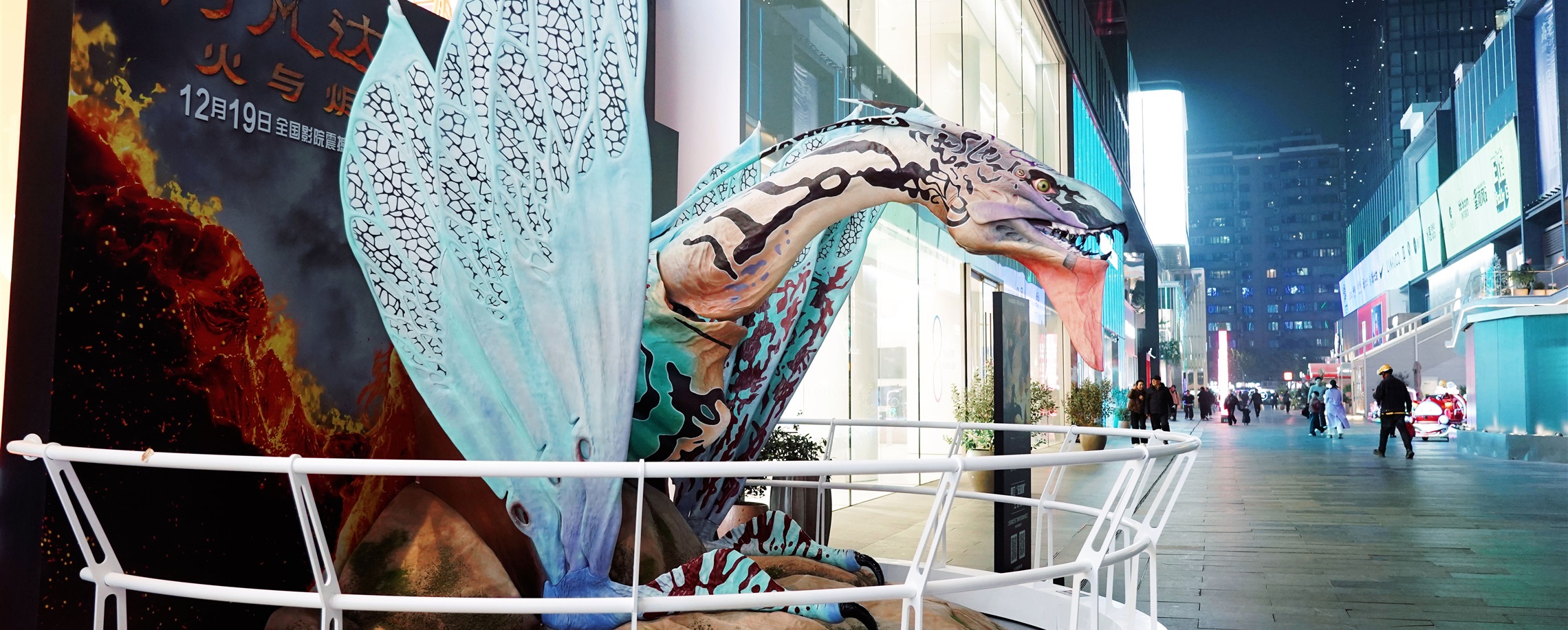Blending flavors: the rising popularity of Brazilian food in Shanghai
Unknown to many, the introduction of a Brazilian steakhouse in Shanghai predates M on the Bund and other upscale Western dining venues.
Back in 1998, Brazilian-Japanese entrepreneur Jun Taichi seized the opportunity to introduce his home country's "churrascaria" (Brazilian steakhouse) experience to Shanghai.
"On my first visit to China in 1998, I recognized the immense potential for authentic Brazilian cuisine in Shanghai," he remarked. The nearly instantaneous decision has led to a mini empire of restaurants. Since the first outlet in Jinjiang Hotel on Maoming Road S. opened its door 26 years ago, Latina Brazilian Steakhouse has expanded to 11 locations in Shanghai and five in other cities across the country.

Born into a family of restaurateurs, Taichi's father opened one of the first Japanese restaurants in Rio de Janeiro and then the first Brazilian steakhouse in Tokyo in 1990, where he started working at the age of 14. "I saw the opportunity to introduce our food culture to a new audience, in the same way my father had done in Japan, and Brazil with Japanese cuisine," he said. "Chinese dining culture values communal eating and sharing, which aligns well with the Brazilian steakhouse experience where unlimited cuts of meat are served and shared. Additionally, the warm hospitality inherent in both cultures made it a perfect match for our dining concept.
"Back then, there were very few Western restaurants and Chinese customers mainly consumed chicken and pork. Beef was typically found in hamburgers or was very tenderized and cooked well done. The concept of rare beef with texture was foreign to most," Taichi recalled, adding he had to source ingredients from a Sino-German joint venture beef supplier near Beijing. "China has developed in an outstanding way and we currently source beef from Brazil, Argentina, Uruguay, Australia and the United States."

A true pioneer, Latina not only brought Brazilian hospitality, but a unique dining experience that continues to be enjoyed by many today.
A Brazilian churrascaria specializes in a barbecue style from southern Brazil where various cuts of meat are grilled on large skewers and served directly at the table. The hallmark of a churrascaria is its rodizio style of service. Rooted in gaucho culture of the Pampas regions, it emphasizes communal dining and social interaction. It reflects Brazil's love for family gatherings and leisurely meals.
"From the very beginning, Latina has offered an authentic steakhouse experience and that's one of the biggest reasons for our longevity," Taichi said, adding they collaborate with Brazilian musicians, chefs and managers to maintain authenticity.


Over the years, they've also progressed in terms of sourcing better quality ingredients and improving the overall ambiance. The menu now includes seafood like lobsters, fresh oysters, scampi, king crab and caviar among other special experiences for customers. "These additions have helped us enhance our offerings while staying true to our roots," Taichi said.
Brazilian food culture is characterized by its blend of indigenous, African, Portuguese and other immigrant cuisines. There are distinct regional specialities such as seafood in the northeast, feijoada (a hearty stew made with black beans and a variety of pork or beef cuts ) in the southeast, and churrasco in the south.

Sao Paulo native Fabiano Coelho is proud of what Brazil can offer and has found market potential to unlock an everyday Brazilian lifestyle.
"I arrived in Shanghai in 2008 and back then you could barely find a place to sip a good caipirinha. Only Latina was serving Brazilian food. Although we love cooking at home, it was very difficult to find the right ingredients to prepare a proper meal apart to BBQ. We could not find all the special premium cuts we have now in town," he said.
The lack of a Brazilian bar in Shanghai led Coelho to draft a business plan in 2009. To make his dream come true, he started a trading company and joined some beer festivals. "I was surprised not only that the Brazilian community was coming, but also some locals were queuing to try our snacks and caipirinha."
In 2017, Coelho opened his first Boteco inside lifestyle hub Found 158. It represents typical after-work hang-out spots in Brazil that serve delicious bar snacks and meat cuts along with caipirinhas, Brazil's world-famous cocktail.


"We've tried to educate the market by not ordering only steak with fries, but instead trying our cassava chips or sticks to go along," Coelho said. "We show to customers that our tapas are more tasty when you eat it with your fingers instead of using cutlery."
Boteco probably offers the best caipirinha in town. This refreshing and tantalizing drink combines cachace, a sugarcane spirit, with muddled lime and sugar, resulting in a delightful concoction that captures the essence of Brazil in every sip. "When we explain how the caipirinha is made, our Chinese customers are very curious to try different fruits apart to the classic lime flavor."
Catering to discerning young Chinese foodies, both restaurateurs are ready for the rapid changes. "We are focused to show our food with a better presentation and look more appealing to customers," Coelho said.
"We've noticed there's been a market shift towards health-conscious and sustainable dining as well as a movement of embracing simplicity and tradition," Taichi said. "This led us to create a new concept called Latina Parrilla, where we source grass-fed beef cooked on a wood-fired grill using traditional Gaucho cooking methods."
Taichi also emphasized an increased interest in Brazilian beverages within their restaurants. They started to import guarana, cachaca, wines and spirits from Brazil.

Regarding beverages, Brazilian coffee is probably the most well-known in Shanghai. In 2010, Brazilian Chinese Jannie Jian brought her four kids to Shanghai to learn Chinese while starting a business importing Brazilian wines and coffees. She brought in premium coffee brand Uniquecafes from Minas. "I believe the specialty coffee market has big potential in the future as an increasing number of locals appreciate having coffee," she said.
"My original intention was to share my love for delicious Brazilian snacks and quality coffee with local Chinese." In 2017, she established her brand, Donna Jannie, specializing in authentic Brazilian snacks. She has standardized the production of authentic Brazilian frozen snacks catering to both locals and expats. Some well-loved options include pao de queijo, coxinha and brigadeiro.
"I'm both Chinese and Brazilian so my products embody the mutual inclusivity of both cultures. I've developed a special mooncake inspired by Brazilians living in China who are not accustomed to the traditional Chinese mooncake fillings. My special mooncakes feature Brazilian flavor fillings such as chocolate, coconut, and peanut that have been very popular for the past three years."


The first wave of Chinese immigrants arrived in Brazil in the early 20th century and Chinese food culture slowly changed, resulting in a unique blend of traditional Chinese culinary practices and local Brazilian flavors and ingredients.
"Chinese food culture has made a significant impact in Brazil with one example being the pastel, a deep-fried pasty filled with various ingredients, such as cheese, meat, chicken, heart of palm. It resembles a Chinese spring roll or wonton, but has evolved into a popular Brazilian snack over the years which we serve in our restaurants," Taichi said.
Coelho also recalled that he often visited Chinatown in Sao Paulo (the biggest in South America) as a student and later as a young lawyer. "There were some days I was just craving fried rice or noodles with delicious steamed veggies," he said. "I can say I knew how to handle the chopsticks since a very young age. To celebrate the 50 years of friendship between China and Brazil, Boteco will feature a limited edition menu of our Chinese-Brazilian way of making Chinese food in Brazil."


![[Expats & Ailments] Malaysian Children Thank Shanghai Doctors for Saving Their Lives](https://obj.shine.cn/files/2025/12/13/e9a200be-df6b-44e6-87ef-581c0943bb08_0.jpg)

